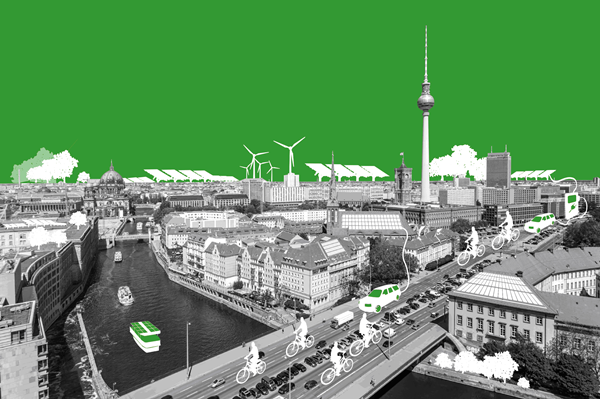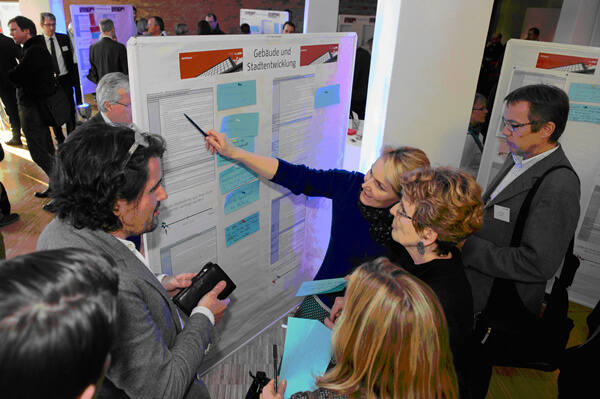Berlin, Germany
Project 1: Climate-Neutral Berlin 2050

Background Information
The central instrument of the “Berlin Energy and Climate Protection Programme (BEK)”, serving as a “roadmap”, contains the strategies and measures that Berlin shall take to achieve climate neutrality. The BEK as well as the climate neutrality target are obligatory for the Berlin government under the Berlin Energy Transition Act (Energiewendegesetz) which came into writ in April 2016. Measures and strategies to adapt to the consequences of climate change have been set out in a separate adaptation strategy.
Goals of the Initiative
The new Berlin energy and climate protection policy pursues an integrated approach and is associated with a range of expected effects. The objective of climate neutrality is the reduction of carbon dioxide emissions by at least 85 percent by 2050, and includes the interim objectives of at least a 40 percent reduction by 2020, or at least a 60 percent reduction by 2030. Alongside the goal of climate protection, further effects of utilization will arise in the local economy, as well as a high quality of life in the city overall.
Parties and Partners to the Initiative
The success of the transformation to a climate-neutral Berlin depends largely on the acceptance by the city’s society. That is why the BEK has been created with broad public participation. Partnerships with the local economy are crucial as well. It includes climate protection agreements with large companies, such as large utility companies and city housing associations. In addition, the implementation of the BEK will be supported by a Climate Protection Advisory Council (Klimaschutzrat) made up of representatives from business and science.
Resources Used for Implementation
The Special Unit for Climate Protection and Energy operates with a separate budget. Between 2016 and 2020, funding of around €110 million has been proposed for the implementation of the BEK to further additional federal state funding that could not yet be estimated at present.
Innovation for the Initiative
The strategy is both evolutionary and revolutionary. Berlin has been pursuing a climate protection policy since the 1990s. There has never before been such a central and integrated consideration of the issue, however, which is now reflected in the BEK. Broad public participation is also new. The Energy Transition Act is an innovation as well. For the first time, there will be a comprehensive monitoring of the strategy’s implementation.
Innovation has been applied in
The new strategy, in principle, is made up of a number of individual measures. The purpose of the BEK is to coordinate the whole strategy. Climate protection is a cross-sectional task. Different spheres of life in the city will be addressed in the BEK and the Berlin Energy Transition Act (energy supply, economy, buildings/urban development, transport, private households/consumption). The role of the Berlin administration is noteworthy, which is a central theme throughout the strategy. With a range of measures in respect to public buildings, working methods, and the involvement of the district level, authorities shall lead by example.
Obstacles and Solutions for Innovation
Climate protection affects all areas of life in the city. As far as this was concerned, it was important to harmonize the different interests. Particularly in the area of climate change, there are always conflicts of aims with other interests, such as social and economic factors. That is why these have been mapped out and solutions to these problems shown. In addition, the participative process has created acceptance. The setbacks and resistance were therefore relatively low.
Outcomes and Assessments
First, carbon dioxide emissions shall be saved in particular by saving energy, moving away from fossil fuels and developing the use of renewable sources of energy. Berlin has already reduced its carbon dioxide emissions by a third in comparison to 1990. To achieve the climate neutrality objective, efforts must be strengthened significantly. This also includes sustainable urban development as a whole. Investments in climate protection will have positive effects on the local economy and create jobs.
The Statistical Office for Berlin-Brandenburg has calculated the energy and carbon dioxide footprint for Berlin. To monitor the implementation of the BEK, a digital monitoring and information system is also being developed. Monitoring serves to check the implementation of the measures in particular, its effectiveness and acts as the basis for correction and management. So far 200 activity-based indicators have been developed. Monitoring is being carried out by the Special Unit for Climate Protection and Energy, which is responsible for implementing the BEK.
Methods Applied
The BEK has been developed through a participative process. That is why the relevant participation formats must be mentioned. In regards to the different events and an online participation platform, the specialist audience and general public had the option to submit suggested measures and/or to comment on the measures proposed. Involvement shall also be permanently established during the upcoming implementation of the BEK. The digital monitoring and information system intended to monitor the implementation of the BEK must also be noted. This tool is a new method in Berlin's energy and climate protection policy.
Benefits to Other Cities
With this strategy Berlin will assume its responsibility as a growing metropolis by making an effective contribution to national and international climate protection, and act as a “showcase” for effective urban climate protection for other cities and metropolises in Germany and across the world.
Project 2: M4guide - Mobile Multi-Modal Mobility Guide

Background Information
As part of the "Von Tür zu Tür ("From Door to Door”) research initiative, a mobility initiative for the local public transport network of the future, the Federal Ministry for Economic Affairs placed four million euros at the disposal of the m4guide project. The companies involved contributed an additional 1.6 million euros.
Goals of the Initiative
The m4guide app is aimed primarily at approx. 145,000 blind and approx. 1.2 million visually impaired citizens of Germany. M4guide was primarily conceived as a product for anyone who is attempting to orientate themselves in an unfamiliar urban context. The first application will be implemented in Soest and Berlin. An extension to other areas is also planned for the long-term.
Parties and Partners to the Initiative
M4guide was developed under the control of the Senate Department for Urban Development and Environment, together with the German Association for the Blind and Partially Sighted, the district of Soest and five other research partners (Fraunhofer FOKUS), IT (BLIC, IVU, HaCon), transport companies (RLG, BVG) and the Verkehrsverbund (VBB transport association).
Resources Used for Implementation
With its particular focus on pedestrian navigation for the blind and visually impaired, the m4guide project was enthusiastically supported by the German Association for the Blind and Partially Sighted and Fichtenberg Secondary School Berlin. As such, requirement catalogues and user profiles were created, and function tests conducted.
Innovation for the Initiative
The project comprehensively uses the possibilities offered by digitalisation. High-precision photogrammetric survey photographs were produced as part of a street investigation exercise, on which basis extensive vector geo-data was obtained to illustrate the streetscape of the district of Berlin-Mitte in unrivalled accuracy and completeness. This data – together with the real-time data on restrictions in the Berlin streetscape provided by the Berlin Administration forms the data basis for the project. Additional real-time timetable data is available for navigation in the local public transport network. These are based on existing travel information systems for local public transport. In the areas of tracking (outdoor and indoor) and highly topical locating methods, routing and route guidance components were developed. A complex total architecture of servers and services connects the components with one another. The app developed for Android implements the desired functionalities, thus enabling safe navigation from door to door.
Innovation has been applied in
If the concepts, procedures and components developed in the m4guide are implemented in the VBB Fahrinfo app and scaled correspondingly, the mobility of all citizens will be enhanced. The navigation from the front door to the contact’s office using public transport breaks down barriers against participation in social activities and provides security in everyday life. Personal restrictions with regard to mobility are taken into consideration.
With the preparation of street data from the m4guide project and investigations in other districts, for the first time the state of Berlin is providing a free broadly based data basis across the public streetscape. Building on that, private citizens or start-ups can generate economic added value.
Obstacles and Solutions for Innovation
As part of the project, an acquisition catalogue still needs to be created for various street objects and their significance for pedestrian traffic, which has not been recorded thus far. Pedestrian tracking is still problematic in inner-city areas and in buildings with current Smartphone technology. For this reason, innovative solution concepts were developed as part of the project.
Between outdoor navigation, public transport route guidance and indoor route guidance, a complex overall architecture of servers and services needs to be implemented into the existing offer.
Outcomes and Assessments
The objective is to develop a consistent transportation navigation system that includes all forms of transportation. This system will help blind and visually impaired people travel from place to place in an unfamiliar urban environment whether they are on foot, using public transport, at train or bus stations or at citizen’s offices. This objective is not an isolated solution. It is a preparation for integration into the FahrInfo information system for the VBBs. Mobility is strengthened for blind and visually impaired people, as well as all others who require orientation for daily journeys across the whole of Berlin and the surrounding area in Brandenburg. Through a joint solution for the blind and visually impaired, and others, the sustainable integration of a specific group of people is supported.
Methods Applied
As part of the project, new data models and acquisition rules for a multitude of street objects and traffic areas were developed that have not been recorded in this way and to this extent in Germany thus far.
Navigation in urban areas with strong shading is supported by the underlying data model of footpaths in order to enable the blind and visually impaired pedestrians to better orientate themselves.
In the absence of satellite navigation systems in indoor spaces, a tracking solution was developed by Fraunhofer FOKUS utilising sensor fusion, including Wifi field density, inertial sensors, Bluetooth and optical technologies.


 In Focus | World Cities Day: People-Centred Smart Cities
In Focus | World Cities Day: People-Centred Smart Cities City Stories | Fostering community resilience: A lifeline for the Central African Republic
City Stories | Fostering community resilience: A lifeline for the Central African Republic In Focus | Innovative Education, Empowering Futures
In Focus | Innovative Education, Empowering Futures




















 Tel: +86 020 3780 4434
Tel: +86 020 3780 4434 Email: info@guangzhouaward.org
Email: info@guangzhouaward.org Adress: Unit 01-7, 28th Floor, No. 7, Chunrong 3rd Road, Tianhe District, Guangzhou, Guangdong, 510000, PRC
Adress: Unit 01-7, 28th Floor, No. 7, Chunrong 3rd Road, Tianhe District, Guangzhou, Guangdong, 510000, PRC




